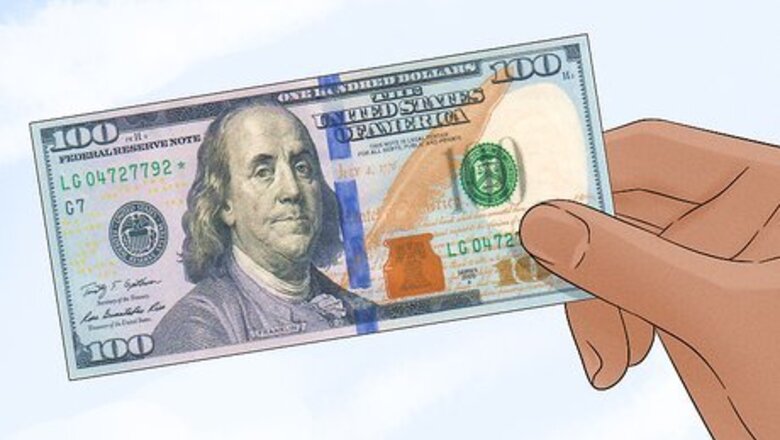
views
Examining Security Features

Hold the bill up to the light. For all bills except $1 and $2 dollar bills, there should be a security thread (plastic strip) running from top to bottom. The thread is embedded in (not printed on) the paper and runs vertically through the clear field to the left of the Federal Reserve Seal. On authentic bills, this should be easily visible against a light source. The printing should say "USA" followed by the denomination of the bill, which is spelled out for $10 and $20 bills but presented in numerals on the $5, $50 and $100 bills. These threads are placed in different places on each denomination to prevent lower-denomination bills being bleached and reprinted as higher denominations. You should be able to read the inscriptions from both the front or back of the note. Also, it should only be visible against a light source.

Use an ultraviolet (black) light to look at security threads. Plastic strips in high-denomination bills should glow a specific color. The $5 dollar bill should glow blue; the $10 bill should glow orange; the $20 bill should glow green; the $50 bill should glow yellow; the $100 bill should glow pink. If your bill remains white under a black light, it is likely a counterfeit.

Check for watermarks. Use natural light to see if your bill bears an image of the person whose portrait is on the bill. Hold the bill up to a light to check for a watermark. A watermark bearing the image of the person whose portrait is on the bill can be found on all $10, $20, $50, and $100 bills series 1996 and later, and on $5 bills series 1999 to 2006. For $5 bills series 2006 and latter, the watermark is of a 5 instead of Lincoln's portrait. The watermark is embedded in the paper to the right of the portrait and should be visible from both sides of the bill.

Tilt the bill to examine the color-shifting ink. Color shifting ink is ink that appears to change color when the bill is tilted. Color-shifting ink can be found on $100, $50 and $20 dollar bills series 1996 and later, and on $10 dollar bills series 1999 and later. $5 and lower bills do not yet have this feature. The color originally appeared to change from green to black, but it goes from copper to green in recent redesigns of the bills.
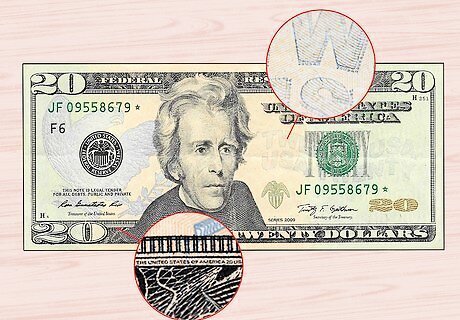
Examine the micro-printing. This includes small words or numbers that are hardly visible to the naked eye and cannot be read without a magnifying glass. Beginning in 1990, very tiny printing was added to certain places (which have periodically been changed since then) on $5 and higher denomination bills. Don't worry about a specific location. Since micro-printing is hard to duplicate, counterfeits usually tend not to have any. Counterfeits with micro-printing tend to have blurred letters or numbers. On a genuine bill, the micro-printing will be crisp and clear.
Judging by Sight

Inspect the printing quality. Fake bills tend to have a relative flatness and lack of detail. Because making real currency involves printing methods that are unknown and therefore extremely hard to replicate, counterfeiters are often forced to improvise. Real U.S. bills are printed using techniques that regular offset printing and digital printing (the most popular tools for common counterfeiters) cannot replicate. Look for blurry areas, especially in fine details such as around the borders. Look for colored fibers in the paper. All U.S. bills have tiny red and blue fibers embedded in the paper. Counterfeiters sometimes try to reproduce these by printing or drawing these fibers onto the paper. As a result, the blue and red fibers will appear to be printed on the paper instead of being part of the paper itself.
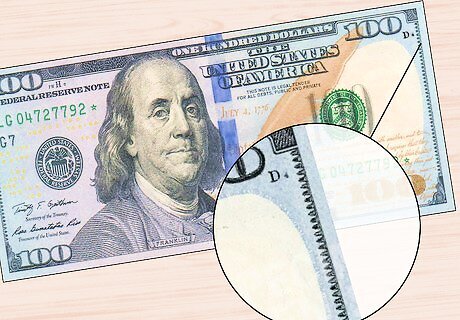
Look at the borders. The outside border of real money should be "clear and unbroken," according to Secret Service officials. On Federal Reserve and Treasury seals, the saw-tooth points of the borders should be sharp and well-defined on genuine bills. Seals on a counterfeit bill often have uneven, blunt, or broken saw-tooth points. Look for bleeding ink. Because of the difference in printing methods between real and fake bills, the border ink can sometimes bleed on a fake.

Observe the portrait. Look at the picture of the person on the bill. There are specific discrepancies that will tell you if the bill is fake. Portraits in fake bills may appear dull, blurred, and flat, while in real currency, the portraits are sharp and contain very fine detailing. On a real bill, the portrait tends to stand out from the background. On counterfeit bills, the portrait's coloring tends to blend too much with the bill. Use a magnifying glass to closely observe the rim of the portrait. There should be the phrase "THE UNITED STATES OF AMERICA" repeated along the sides of the portrait. This will look like a solid line to the naked eye. This feature is especially hard to replicate using office machine copiers or printers due to its size and detail.

Examine the serial numbers. There should be two serial numbers located on the face of the bill on either side of the portrait. Look at the bill carefully and make sure that the serial numbers match. Look at the color of the serial numbers on the bill and compare it to the color of the Treasury Seal. If they do not match, the bill is likely a fake. Fake bills may have serial numbers that are not evenly spaced or that are not perfectly aligned in a row. If you receive multiple suspicious bills, see if the serial numbers are the same on across all bills. Counterfeiters often neglect to change serial numbers on fake bills. If they are the same, then they are counterfeit notes.
Judging by Touch
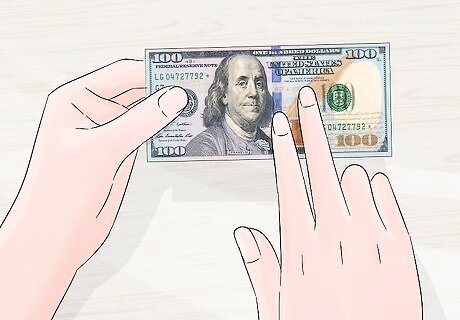
Feel the texture of the paper. Counterfeit money will often feel distinctly different from authentic money. Authentic money is made from cotton and linen fibers. This differs significantly from normal paper, which is made from trees. Real money is made to be more durable and should feel crisp despite its age; normal paper becomes torn and soft when worn. The paper that banknotes are printed on is not sold commercially. Also, the chemical composition of the paper and ink is confidential. Even if you do not have much experience in spotting a counterfeit, you should notice a clear difference in texture. Genuine currency has slightly raised ink that is produced in the intaglio printing process. You should be able to feel the texture of this ink, especially if you are holding a new dollar bill. Run your fingernail over the portrait's vest of the bill. You should feel distinctive ridges. Counterfeiters cannot reproduce this.
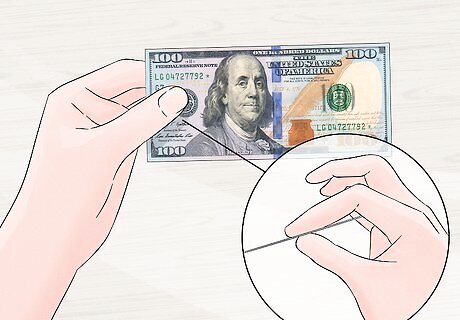
Notice the thinness of the bill. Genuine money is often thinner than counterfeit money. The process for making money involves applying thousands of pounds of pressure during the printing process. As a result, real money should feel thinner and crisper than regular paper. The only option available to most counterfeiters is to use thin rag paper, which can be purchased at most office supply stores. Still, this paper should feel thicker than authentic money.

Compare the bill with another of the same denomination and series. Different denominations will look different, so get a note of the same amount. If you are still suspicious about the quality of a bill, holding it next to a bill you know is authentic may help you feel a difference. All denominations, except the $1 and $2, have been redesigned at least once since 1990, so it is best to compare the suspect bill to one in the same series, or date. While the look of money has changed over the years, the distinctive feel has been left largely unchanged. The feel of a bill made 50 years ago should feel similar to a brand new dollar bill.
Handling Counterfeit Money Correctly

Do not create counterfeit money. It is illegal to possess, produce, or use counterfeit money; if a prosecutor can prove that you have intent to defraud, federal law can punish you with a fine and maximum 20 years in prison. If it is passed to you, do not pass the counterfeit currency on to anyone other by following these instructions. Inspect bills the moment you are suspicious. Remember who gave you which bills. If you acquire a counterfeit banknote, you must turn it into the Secret Service. Not reporting counterfeit banknotes makes you vulnerable to someone else turning you in for counterfeit banknotes.
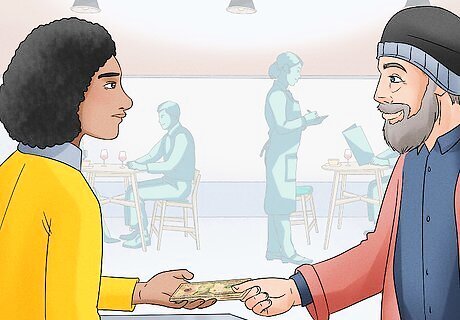
Remember the passer. If possible, delay whoever passed you the counterfeit money to remember as much about that person’s appearance as possible. Take note of any accomplices or companions. Write down their license plate number if applicable. The person who gives you counterfeit money might not be the original counterfeiter. They too might be an innocent civilian duped into using fake money. It might be impossible to match each passer to each specific bill, so many people inspect bills the moment they are handed to them. For example, many cashiers at general stores will inspect large denomination bills before accepting them as payment. This way, the cashier in the moment can link any potential passer to any potentially counterfeit bill.
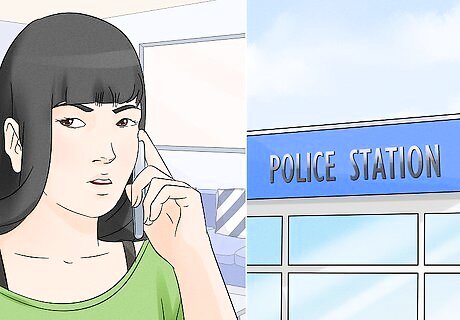
Contact the authorities. Find your local police department or United States Secret Service field office. These numbers can be found on the inside front page of your local telephone directory or through online search.

Avoid handling the banknote. Carefully place it in a protective covering, such as an envelope or sandwich bag. This is so that authorities can glean as much information as possible from the banknote: fingerprints, compounds and chemicals, how it was printed, and so on. This is also so that you cannot forget which banknote was forged, and others are not mistaken.
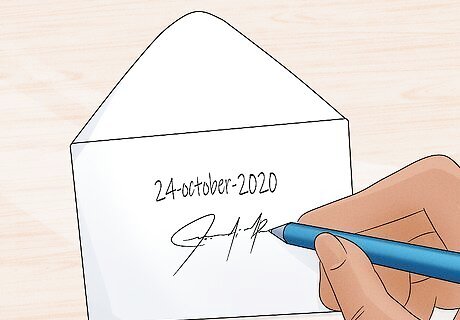
Write down your information. Write your initials and the date in the white border areas of the suspect banknote, or on the envelope/bag. The date identifies when the counterfeit was noticed, and your initials identify who noticed the counterfeit.
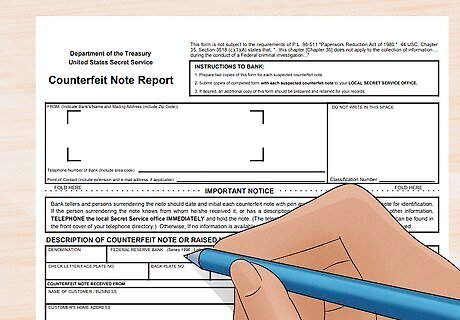
Fill out the Secret Service counterfeit report. When you hand in a counterfeit note, you must fill out the Department of Homeland Security’s Counterfeit Note Report. Find the form here. The URL is https://financialservices.wvu.edu/files/d/56f0976b-6233-48da-a79b-a2133588620d/secret-service-counterfeit-form.pdf. Once a note is handed in with this form, it is considered counterfeit unless proven otherwise. Fill out 1 form for each suspected banknote. This form is geared towards banks who catch counterfeit money, but individuals should use it as well. If you found the counterfeit bill at a bank and you are an employee of the bank, contact your manager and fill out this form regarding your employer.

Give the banknote to authorities. Surrender the note or coin only to a properly identified police officer or a U.S. Secret Service special agent. When asked, relay as much information as possible about the passer, accomplices, or any other information you remember about receiving the counterfeit money. You will not be financially reimbursed for handing in counterfeit money. This is to prevent individuals from receiving money for free, just because they counterfeited money.










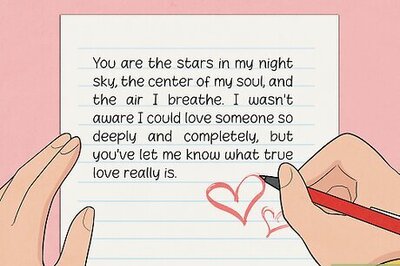









Comments
0 comment